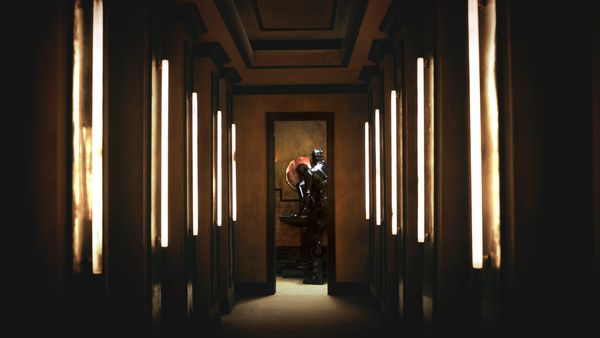 |
| Things are not always what they seem in Piercing Photo: Vertigo Releasing |
Out in selected cinemas in the UK at present and no doubt responsible for some rather awkward belated Valentine dates, Nicolas Pesce’s Piercing tells the story of a man, Reed, whose plan to check into a hotel and murder a sex worker doesn’t play out in the way he expected. A dark comedy with brief moments of brutal violence, it’s otherwise notable for its stunning visual style and the intense performances delivered by leads Christopher Abbott and Mia Wasikowski. Coming after Pesce’s brilliant debut work The Eye Of My Mother, it solidifies the 29-year-old filmmaker’s reputation as one of the brightest talents of his generation.
I was delighted to get the opportunity to speak to the director at this exciting stage in his career, and I began by asking him if he had expected The Eyes Of My Mother to receive the reaction that it did.
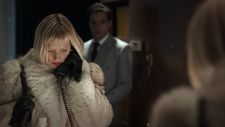 |
| Mia Wasikowska in Piercing Photo: Vertigo Releasing |
“I did not,” he says, laughing. “I think there’s a beauty in feeling that no-one’s going to see it because you get to do whatever you want. I cut the movie in three weeks before sending it to Sundance so I didn’t really think that anything was going to happen and yeah, the fact that people liked it, I was very, very surprised and happy.”
Did he approach Piercing the same way, making it mostly for himself, or was he more conscious of his audience this time around?
“Piercing was a really unique situation because right after I did Eyes Of My Mother I got the job directing The Grudge for Sony so I know I was going to do a studio movie that people were going to see but it took a really, really long time to write and I had enough time to squeeze in another movie. Piercing was with the same financiers and producers as Eyes Of My Mother so it was like I had one more opportunity to squeeze in a movie that was even more just for me. Before, obviously, with a franchise it’s a movie that’s expected to do better numbers in the box office – you have to make certain compromises and can’t be so niche, so I wanted to get in one last movie that was uniquely me.”
I tell him that I recently spoke to Lin Shaye, who stars in The Grudge, and that she was very excited about the film and full of praise for him.
“Well, I’m obsessed with Lin Shaye,” he responds. “I love Lin Shaye so much. She was amazing. And, you know, The Grudge is – well, I grew up with the franchise and I loved, particularly, the Japanese instalment. There’s 12 Grudge movies and they’re all different stories, different characters – they’re not all sequels, it’s an anthology series. So I felt like in this world where everything is being remade, here’s an opportunity to not have to remake something. To get to add to the canon rather than just rehash something. The series has a set of rules and a set of mechanics that every movie does but outside of that there’s a certain freedom. So the movie is its own this stylistically and it takes place in America. We have a great cast.”
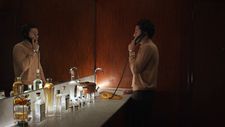 |
| Reed (Christopher Abbott) phones home before the planned killing Photo: Vertigo Releasing |
So why did he choose to adapt Piercing from Ryû Murakami’s novel?
“With Eyes Of My Mother, the one piece of me that I felt like I hadn’t really gotten to play with was the dark sense of humour that I love so much in movies. I look at filmmakers like Takashi Miike and Chan-wook Park and Bong Joon-ho who deal with really dark subject matter but manage to do it with a playfulness that’s really fun but also uncomfortable. So I was looking for something that was dark, dealing with a lot of similar subject matter, like what drives someone to want to be a killer – sorry, my dog is barking.”
Behind the table at which he sits, the dog seems keen to make his voice heard on this topic. Nick takes a moment to quiet him down.
“But something that maybe had a little more playfulness,” he continues, “that I could maybe have a little more fun with it. The novel is pretty much baked into it. Murakami has such a bizarre, fun, Miike-esque sense of humour, so yeah, it felt kind of perfect.”
There are an awful lot of films out there about men killing sex workers. Was he keen to subvert them?
“Totally. I’m such a fan of genre movies, particularly thrillers and horror movies, and it is such a staple of the genre to have: here is this good looking, attractive guy who wants to kill this girl, watch him do it. For the first 20 minutes you think this is that and then it becomes so not that, and that is so fun to me. You look at a movie like Basic Instinct which has a lot of similar twists and turns to Piercing but Piercing handles it in such a fun way, especially for the gender role aspect of it.
“The beauty of it is that Mia’s character never knows that she was supposed to be a victim, never treats herself like that and, as the movie concludes, she is not that. We’ve seen so many movies where you’re either weirdly rooting for the guy to kill the girl because of how the movie has set it up or you’re literally watching these women get killed, and to have this character be like ‘Oh no, no,no,no,no, no. I’m way worse than you! You’ve got nothing on me,’ was such a fun subversion of that and I like playing with genre and the expectations and flipping them.”
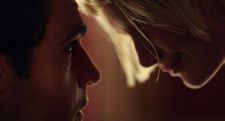 |
| Up close and personal Photo: Vertigo Releasing |
With both Basic Instinct and Piercing, the shadow of Hitchcock looms large. Did he consciously draw on the great director’s style?
“Yeah. I mean, I love Hitchcock and there is Hitchcock in so many aspects of it. But I would say that when I’m paying homage to filmmakers I don’t want to do the same exact thing that they did. I made similar choices but that made sense for us. So for instance, I always loved that Hitchcock did rear screen projection for cars. When someone’s driving it’s a flat shot with a jittery background and I love the way that looks. I wanted to do something like that but you don’t want to make it cheesy to the point where people are laughing at the technique.
“Nowadays they have these things called LED panels which are basically these huge TV screens that are very, very bright. So we basically took a shot of a car driving through a city and put it on an LED screen and put it right behind the car and then just had guys shaking the car, and so you get the same effect that Hitchcock did but with a slightly more contemporary flair. As a result, with our technology, we get a lot more reflections on the glass and that’s how you get a lot of those car window shots in Piercing that Hitchcock wasn’t able to do.
“But then things like the miniatures, you know? I always loved that Hitchcock was going matte paintings and miniatures, and that’s how we built our world. And then Chris [Abbott] and I also talked a lot about Jimmy Stewart and how even in the Fifties and Sixties what Jimmy Stewart was doing was not naturalistic, it was not a standard performance style, and he and Hitchcock found this timeless tone that is silly and wacky but still works as a leading man. I look at things like Vertigo – and Cary Grant did it too in North By Northwest – there’s this quality to Hitchcock’s men and women that is unrealistic and kind of only exists in movies and is magical because of it.”
I confess that the other film I was reminded of, early on, was Pretty Woman, and Nick laughs. It’s partly the haircut Mia’s character has at the start, I say, but it’s also her incredible sweetness – it almost makes us think that she might change Reed’s plan, just by being so human. Did he cast Mia with her capacity to portray that in mind?
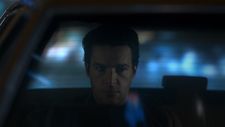 |
| Going for a ride Photo: Vertigo Releasing |
“Yeah. I mean, with Chris, the role was written for him from the start. He was a friend of mine. Chris is a very quiet guy but you see a lot going on in his head, and that was very much a quality for Reed. With Mia, Mia was actually originally cast to play the role of the wife, the role that Laia Costa plays in the movie. The actress who was originally playing Jackie got injured doing tests for another movie three days before we started shooting. She had to drop out. So I called Mia in Australia and I was like ‘Will you, instead of playing the, like, funny wife role that only has to work for two days, will you play the S&M prostitute?’” He laughs. ”An to her credit she just said, immediately, ‘Yes.’
“I think in the book there’s an innocence to her that also further subverts the stereotypes of what a prostitute is in the movies. Murakami, the author, grew up in a red light district in Japan and had a lot of personal connections to the sex industry, and treats it with such respect in his writing. I think something that’s awesome about the character in Piercing is that, well, prostitutes in movies and a very specific kind of strung out, damaged, like junkie...”
The dog once again tries to contribute some observations and Nick tells him to be quiet.
“The character of Jackie – and Mia – has this lightness to her,” he continues. “Even though what’s going on in her head is so dark, she doesn’t need to wear that. When you hear the set-up of a guy calling a prostitute to his hotel intending to kill her, the type of prostitute that Mia plays is not, I think, who you would expect to show up, as I think it’s more accurate to the fact that no one particular kind of person chooses this line of work. It’s a spectrum, as with anything, and I think it was important to portray her in such a way that we haven’t quite seen that.”
Another notable feature of the film is that it’s mostly shot in small spaces. It could work well as theatre. How did he approach the challenge of making it work as cinema?
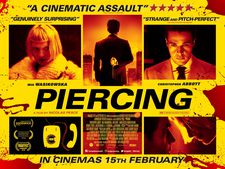 |
| The poster for Piercing |
“I think partly that isn’t a bad thing,” he says. “A lot of Hitchcock feel like theatre, you know? He is a very proscenium filmmaker. Kubrick was too. I always look at filmmaking as sort of voyeuristic. I like to think of it as, like, whatever is happening the camera’s always watching from another perspective. To me there’s something fun about these claustrophobic spaces and confining it so much. You look at David Lynch’s movies, particularly like Blue Velvet, that all takes place in these really basic four-walled sets with, like, one couch, a carpet and one lamp and a table. It’s like super minimal, super unrealistic. Throughout Piercing we were going for this intentionally artificial quality to everything.
“I look at Jacques Tati or Roy Anderson, who made A Pigeon Sitting On A Branch and you get these artificial qualities. Fassbinder did it too. The set’s not fully rendered. It makes everything feel almost real but there’s something off about it and it’s like that uncanny valley thing that makes the world feel uncomfortable and just raises the tension of it all that I really love.”
Like a hotel, which is almost like a home but not quite?
“Totally. Exactly.”
The film spent a while on the festival circuit where it notably made some critics uncomfortable. Did he have any problems securing a cinema release for it?
“We sold the film pretty shortly after Sundance,” he says happily. “I make movies for a very particular audience. I know that they are not for everyone. I think it’s always been a matter of just finding the right partner who knows how to put it to the right people. I also tend to stay out of the business side of the movies,” he says with a self-effacing laugh. “The movie is over for me when I finish it and then getting to show it to people is just like the fun part afterwards.
“We look back on Cronenberg’s work and Lynch’s work and it’s like ‘Oh yeah, everyone must have seen these movies,’ but they didn’t. Those movies were small and they weren’t widely seen and now people can go back and look at them and time erases the fact that, like, no-one thought that David Lynch would ever work again after Dune and then he made Blue Velvet. And non-one saw it but when he got nominated for an Academy Award ten years later people were like ‘Ohhh, David Lynch!’ So history is weird but in terms of releasing movies, all my favourite movies were movies that I did not see in theatres because they came out before I was born, or they were not on a traditional release so I had to hunt them down and find them, and that added to it, you know? Like how hard I had to work to see Audition the first time I ever saw it was like part of the magic of that movie.
“The right audience will always find the movie.”
Piercing is now available to own on Digital HD.





















